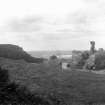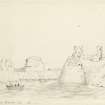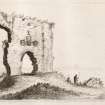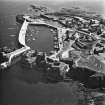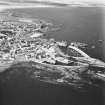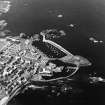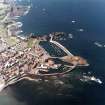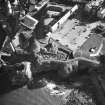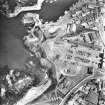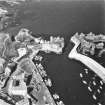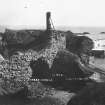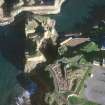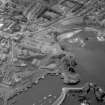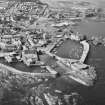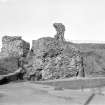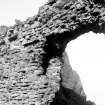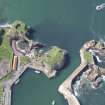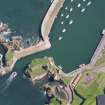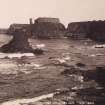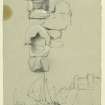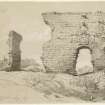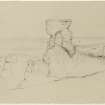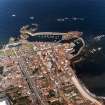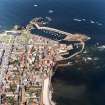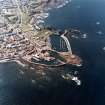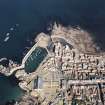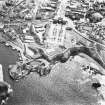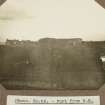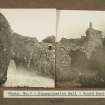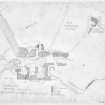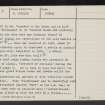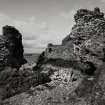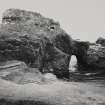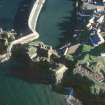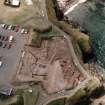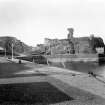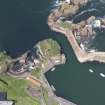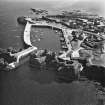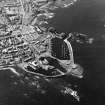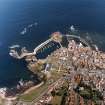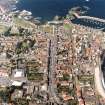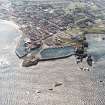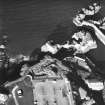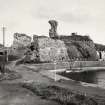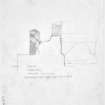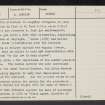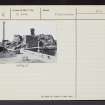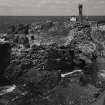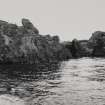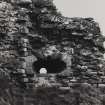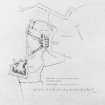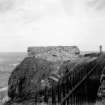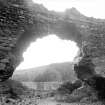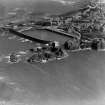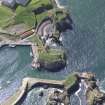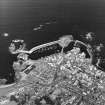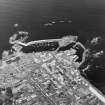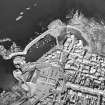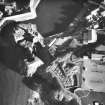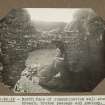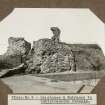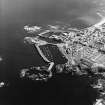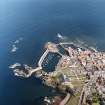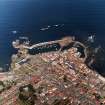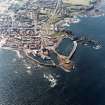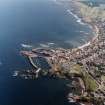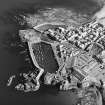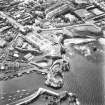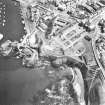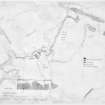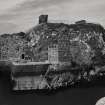Dunbar Castle
Castle (Medieval)
Site Name Dunbar Castle
Classification Castle (Medieval)
Alternative Name(s) Dunbar, Victoria Harbour, Castle; Castle Rock
Canmore ID 57687
Site Number NT67NE 8
NGR NT 67849 79332
Datum OSGB36 - NGR
Permalink http://canmore.org.uk/site/57687
First 100 images shown. See the Collections panel (below) for a link to all digital images.
- Council East Lothian
- Parish Dunbar
- Former Region Lothian
- Former District East Lothian
- Former County East Lothian
NT67NE 8 6782 7930
See also NT67NE 24, NT67NE 26, NT67NE 147.
Not to be confused with Lamer Island, Battery (NT 68112 79348), for which see NT67NE 53.
(Area NT 6782 7930) Dunbar Castle (NR) (Ruins of)
(NT 6781 7933) Queen Mary's Room (NR)
(NT 7977 7929) Fort (NR)
Entrance to subterranean Passage
OS 6" map (1854)
On a very bold and exposed site, adjoining the new harbour [NT67NE 147] to the north of the town, the fragmentary remains of Dunbar Castle are scattered over a rock standing 80 feet above the sea, which surrounds the site on three sides today and originally cut it off almost entirely from the mainland. On the east, a large freestanding mass, naturally cleft, is made continuous by masonry and on this the castle proper stood; an isolated and precipitous rock 25 yards to the south-west is surmounted by a great battery and united to the castle by a massive screen wall of masonry containing a mural passage giving communication between these portions.
The remains of building yearly become less, since no attempt at conservation is made. The main portion of the site has been cleft to provide an entrance to the new harbour, and in this operation portions of the castle buildings have been destroyed.
The remains appear to be those of a castle with gatehouse and a walled enceinte. The masonry is of the local red freestone, ashlar faced and rubble cored. The gatehouse is of a 15th century type and probably is what is left of the 'barbican' then erected. The numerous gunloops are evidence of a relatively late date. Miller (1859) gives the dimensions of the main portion as 165 feet from east to west with a length of 207 feet from north to south.
The isolated battery is inaccessible, for the connecting passage, which is 69 feet long, is broken. This must be the early 16th century 'blockhouse' referred to below. The structure is roughly octagonal on plan and measures 54 feet by 60 feet within walls 8 feet thick ,which are recessed to form gun emplacements. These have gun ports 4 feet wide externally, diminishing to 16 inches at daylight. Grose (1789) and Miller in their illustrations show the curtains terminating in salient circled and angular towers, which are said by Miller to have had communication with the sea, and 'to dip low in many places'.
HISTORICAL NOTE - The importance of the Dunbar position is obvious. The castle covered the most convenient landing on the coast beyond Berwick, and after Berwick became finally English in 1483 that importance was intensified for Scotland. But the present ruins do not quite represent either the castle for the possession of which a battle was fought with the army of Edward I in 1297 or that defended against the Earl of Salisbury for five months in 1338 by 'Black Agnes, Countess of Dunbar'. In 1487 it was 'annexed to the Crown and in 1488 ordered by Parliament to be 'cassyne doune and alutterly distroyit in sic wise that ony fundment tharof be occasioun of biging nor reparcione of the said castell in tyme to cum' (Acts Parl Scot). When war occurred in 1496, James IV found it advisable again to construct a castle at Dunbar.' This was apparently completed in 1501. A chapel dedicated to St John was also built (Accts Lord High Treas).
In the next reign Dunbar Castle was possessed by John, Duke of Albany, 'Governer of Scotland' during the minority of James V. He is said to have had built 'in the samin ane great staine house and insche callit the uttivant blokehouse and garnist it with artaillze pulder and bullattis'. This 'blockhouse' may be identified with the round structure (marked 'Fort' on the OS map) on what would have been an isolated mass ('inshoe = island) before being linked up with the rest by a bridge. In 1558 it was reported that 'the castle is old, full of old buildings (Scottish Papers) but in the spring of 1560 the castle was refortified by the French (Scottish Papers; State Papers, Foreign).
These French fortifications were probably in the main of earth and had to be destroyed in accordance with the Treaty of Leith (6th July 1560) where the reference is to 'rasing the new buildings at Dunbar (Scottish Papers). After April 24th, 1567, when Queen Mary was held prisoner in the Castle by Bothwell, Parliament ordered its demolition since it was no longer an effective means of defence (Acts Parl Scot).
A panel bearing the arms of George, 10th, Earl of Dubar (d. 1416) was in position above a large doorway until October 21, 1869, when it was blown down in a gale (F Grose 1789).
RCAHMS 1924
The date of erection of Dunbar Castle is not known, but in 858 it was burnt by Kenneth, King of Scotland. 'In 1073 it appears to have belonged to the Earls of March'.
F Grose 1789
In an account of the siege in 1337, it is stated that the postern at Dunbar Castle had a portcullis.
W M Mackenzie 1927
'A fortalice was there (at Dunbar) at an early period, certainly as early as the 9th century'.
T W Fish 1930
The remains of Dunbar Castle are as described above.
Visited by OS (DT) 28 August 1962
NT 678 791. An extended watching brief on a service trench revealed the following:- a stone-built culvert which may have been contemporary with the 19th century barracks; disturbed human bone and three truncated human burials probably in a medieval graveyard; part of a substantial rubble-built wall believed to be part of the 16th century French fort defences; a deposit of rubble and lime, perhaps part of a post medieval industrial process or mortar marking; part of an iron spur recovered from a deposit of silty loam contained animal bone possibly dating to the post medieval period.
Sponsors: SUAT, HS
R Cachart 1991.
NT 678 793. A fourth phase of excavation on the headland took place during November and December 1991. Four main phases of activity were identified.
Phase 1. The earliest activity on site consisted of a N/S ditch which formed part of the defences of the Native British promontory fort identified in the earlier excavation. This was followed by Dark Age activity.
Phase 2. Dark Age activity consisted of a possible large sunken floored building surrounded by two concentric post-trenches. Unfired clay loomweights were recovered from the floor of this feature.
Phase 3. Medieval occupation on the site was associated with Dunbar Castle. The foundations for the curtain wall were excavated as was an associated cobbled surface.
Phase 4. In the early post-medieval period part of the curtain wall was robbed out, presumably to be used in the construction of the 16th century French fort.
Sponsors: Historic Scotland, East Lothian Community Development Trust.
C J Moloney 1992.
On the whole as RCAHMS description. Dunbar Castle is closed to the public because of the danger of collapse, large blocks of masonry, some up to 5m in length, are visible in the small bay to the west of the castle and the entire structure is in a poor state of preservation.
Site recorded by GUARD during the Coastal Assessment Survey for Historic Scotland, 'The Firth of Forth from Dunbar to the Coast of Fife' 1996.
NT 678 793 A watching brief was undertaken at Dunbar Castle in May 2002 during the excavation of holes to receive posts for a new fence. There were no finds or archaeological features of interest.
Archive to be deposited in the NMRS.
Sponsor: Dunbar Harbour Trust.
G Ewart and D Stewart (Kirkdale Archaeology) 2002.
Non Guardship Sites Plan Collection, DC/23408 to DC/23415, 1837, 1857, 1860, 1879, 1924, 1977 and 1978.
EXTERNAL REFERENCE:
NATIONAL LIBRARY OF SCOTLAND
General Hutton Manuscripts volume 1 nos 28 and 29, sketch.
Field Visit (25 May 1920)
On a very bold and exposed site, adjoining the new harbour [NT67NE 147] to the north of the town, the fragmentary remains of Dunbar Castle are scattered over a rock standing 80 feet above the sea, which surrounds the site on three sides today and originally cut it off almost entirely from the mainland. On the east, a large freestanding mass, naturally cleft, is made continuous by masonry and on this the castle proper stood; an isolated and precipitous rock 25 yards to the south-west is surmounted by a great battery and united to the castle by a massive screen wall of masonry containing a mural passage giving communication between these portions. The rock is a brown basalt, fissured and caverned by the water. The remains of building yearly become less, since no attempt at conservation is made. The main portion of the site has been cleft to provide an entrance to the new harbour, and in this operation portions of the castle buildings have been destroyed.
The remains appear to be those of a castle with gatehouse and a walled enceinte. The masonry is of the local red freestone, ashlar faced and rubble cored. The gatehouse is of a 15th century type and probably is what is left of the 'barbican' then erected. The numerous gunloops are evidence of a relatively late date. Miller (1) gives the dimensions of the main portion as 165 feet from east to west with a length of 207 feet from north to south.
The isolated battery is inaccessible, for the connecting passage, which is 69 feet long, is broken. This must be the early 16th century 'blockhouse' referred to below. The structure is roughly octagonal on plan and measures 54 feet by 60 feet within walls 8 feet thick, which are recessed to form gun emplacements. These have gun ports 4 feet wide externally, diminishing to 16 inches at daylight. Grose (1789) and Miller (1830) in their illustrations show the curtains terminating in salient circled and angular towers, which are said by Miller to have had communication with the sea, and 'to dip low in many places' (fig. 62).
HISTORICAL NOTE - The importance of the Dunbar position is obvious. The castle covered the most convenient landing on the coast beyond Berwick, and after Berwick became finally English in 1483 that importance was intensified for Scotland. But the present ruins do not quite represent either the castle for the possession of which a battle was fought with the army of Edward I in 1297 or that defended against the Earl of Salisbury for five months in 1338 by 'Black Agnes, Countess of Dunbar'. On the latter occasion the place was blockaded on the sea side by two great galleys and other smaller ships, but Sir Alexander Ramsay, on a stormy night, slipped through in a vessel from the Bass with food and reinforcements (2). Experience showed that the strongholds had been serviceable mainly to English invaders or to rebellious lords in league with that country. Therefore, after the example on this line given by the Duke of Albany and Earl of March, brother of James III, it was in 1487 annexed to the Crown and in 1488 ordered by Parliament to be 'cassyne doune and alutterly distroyit in sic wise that ony fundment tharof be occasioun of biging nor reparcione of the said castell in tyme to cum' (3). But this policy, of course, worked both ways. It did not present the invader with a fortified postion, but neither did it provide the defender with a fortified position where one was required; it only left open a sea-gate to the Lothians. Therefore, when war occurred in 1496, James IV. found it advisable again to construct a castle at Dunbar. On 10 March 1497 Sir Andrew Wood got £5 to buy lime for the building of Dunbar. Early in April the King himself was at the place and quarriers were at work preparing stones, clearing the site that the masons might get to work and ‘wynning’ the well. The mason work was in the hands of Walter Merlioune, one of a family of masons employed by the King, and in April the ‘forwerk’ was in hand. During April payments were being made to Sir Andrew Wood for the work at Dunbar. Roofing beams for ‘Hannis toure’, and other beams and rafters were being bought and forwarded to the building. Hans was one of the King's gunners, a Dutchman apparently. In May, gate nails and ‘dowbil byspikars’ for the ‘yettis’, door nails, and ‘gret wraklin nalis’ were being provided, with 200 ‘seme and ruffis’ i.e. bolts and rivets for ‘the yet of Dunbar’, while Thom Barker had to go down to take the measure of the iron gate ‘to mak it’. The doors were hung by ‘bands’ on ‘crukis’ of iron. A chamber was built after the measurements of the King's chamber at Edinburgh. There was also a pended or vaulted Hall. In August Hans Tower was being roofed. Not, however, till 1501, when the buildings apparently were completed, do we hear of the ‘iron windows’ being got ready. A chapel dedicated to St. John was also built (4).
In the next reign Dunbar Castle was possessed by John, Duke of Albany, ‘Governor of Scotland’ during the minority of James V. He is said to have had built ‘in the samin ane great staine house and insche callit the uttwart blokehouse and garnist it with artaillze pulder and bullattis’ (5). This 'blockhouse' may be identified with the round structure (marked’ Fort’ on the O.S. map) on what would have been an isolated mass (‘insche’ = island) before being linked up with the rest by a bridge. In 1547 the English considered the occupation of Dunbar as an alternative to Haddington (cj. Introd. p. xxix): it was later urged by Lord Grey that ‘a great part of Dunbar town is beyond danger of shot, and if fortified may ‘inrynge the castle and some partmak it’ (6). In 1558 it was reported that’ the castle is old, full of old buildings, and who ever is stronger on land could batter it with 10 or 12 pieces and gain it’ (7). But in the spring of 1560 the castle was refortified by the French and was thereafter declared to be ‘mare ample by the dowbill then it was off before and capable’ of 500 men at least more than it could contain before (8). These French fortifications were probably in the main of earth, as might be expected, and had to be destroyed in accordance with the Treaty of Leith (6 July 1560) where the reference is to ‘rasing the new buildings at Dunbar’ (9). The work was allotted to East Lothian barons and lairds, each group of these with their tenants and vassals accounting for the demolition of so much, the details of which are specified as ‘rampire’, counterscarp, ‘great platfourme’, ‘flanker’, ‘blockhowse’. Included is the ‘ditch from the castle cross (cf. Art. No. 38) to the captain's garden’ (10). No houses are mentioned. It was to the Castle that Queen. Mary fled from the murderers of Riccio; also to the same place, Bothwell, who had just been appointed Keeper, brought the Queen after seizing her and her company near Edinburgh (April 24, 1567). Thereafter it was ordered by Parliament to be demolished; its reconstruction had been costly, it was again becoming ruinous and would require inconvenient expenditure to put in repair, while it was in any case ‘unprofitable to the realm and notable to defend the enemies thereof in case the same were assaulted’ (11).
Until October 21, 1869, when it was thrown down by a high gale, there stood on the site a considerable piece of wall with a large doorway, above which was a group of panels carved with arms, forming ‘what must originally have been a splendid example of mediaeval sculpture’ (12). The high central panel bore a lion rampant within a bordure of roses having an elaborate crest above, which, in 1868, was much decayed but which Miller says (1830) shows a ‘horse's head bridled’. On the dexter a shield contained three legs conjoined for the Isle of Man, while that on the sinister displayed the saltire and chief of Annandale. As George the 10th Earl of Dunbar (d. 1416) was the first to bear the central arms, while Annandale had gone to the Douglases when he was restored to his Scottish possessions in 1409, these bearings can apply only to him and must therefore have escaped the destruction of 1488.
RCAHMS 1924, visited 25 May 1920.
(1) Miller's Dunbar, p. 4; (2) Scotich. Lib., xiii., c.xli.; (3) Acta Parl. Scot. ii., p. 2II;(4) Accts. Lord High Treas. s.a.; (5) Pitscottie's Chronicle of Scotland, S.T.S., vol. 1., p. 303;(6) Scot. Pap. i., No. 174; (7) Ibid, p. 208; (8) Ibid, No. 862; Cal. St. Pap. For. I559-60; pp. 404, 482; (9) Scot. Pap. i., No. 855; (10) Ibid, p. 484; (11) Act. Parl. iii., p. 33; (12) Archaeological Association Journal (with illustration) xxv. (1869) p. 344 ff. See also Grose's Antiquities of Scotland i., p. 88.
Publication Account (1981)
A castle at Dunbar dates from at least 1296 when a battle was fought for its possession between the Scots and the English. Late in the reign of James III the castle was forfeited and in the following year, 1488, was ordered to be 'cassyne doune' and utterly destroyed (RCAM, 1924, 26). The castle was ordered to be rebuilt in the following reign, at which time additions included a vaulted hall and a chapel dedicated to St John. A castle blockhouse was added in the reign of James V. French troops in 1560 fortified the castle with earth, but under the terms of the treaty of Leith the fortifications had to be dismantled. In 1567 the castle was finally ordered to be demelished (RCAM, 1921, 27). The fragmentary castle ruins oecupy a very bold situation. The remains are scattered over a rock standing 80 feet above the sea, which surrounds the site on three sides. In 1830 the body of the building measured about 165 feet from east to west and in some pl aces 20.7ft from north to south (Miller, 1830, 2). About the middle of the fortress was part of a wall through which there was a gateway surmounted by an armorial bearing. Much of the ruins as described by Miller in 1830 was affected by the channel for the new harbour in 1842 which cut through the site of the Great Hall, while further damage occurred in a gale in October, 1869.
Information from ‘Historic Dunbar: The Archaeological Implications of Development’ (1981).
Watching Brief (6 May 2002)
NT 678 793 A watching brief was undertaken at Dunbar Castle in May 2002 during the excavation of holes to receive posts for a new fence. There were no finds or archaeological features of interest.
G Ewart and D Stewart 2002
Sponsor: Dunbar Harbour Trust
Kirkdale Archaeology
Field Visit (March 2014)
ShoreUPDATE March 2014
As described. The east side of the rocky promontory on which the castle stands forms the western side of the harbour, with a modern quay built against it. Although the building is in poor condition, the main threat is posed by structural decay and collapse of the stonework rather than coastal erosion. The castle and its immediate surroundings remain closed to the public.
Visited by Scotland's Coastal Heritage at Risk (SCHARP) 2014
Watching Brief (14 March 2020 - 18 March 2020)
NT 67841 79293 AOC Archaeology Group was commissioned by Dunbar Harbour Trust to carry out an archaeological watching brief on ground-breaking works associated with the development of a new area which will house harbour sheds. The site was located directly next to Dunbar castle (Scheduled Monument SM no. 766). This work uncovered a deep and concentrated deposit of castle rubble located in the cove to the south of the existing castle. The deposit contained large fragments of demolished castle wall, stones, mortar and three finds of handmade bricks. In addition to this rubble a small section of compacted pebble surface was uncovered nearby the existing castle remains on the edge of the present-day harbour.
Information from OASIS ID: aocarcha1-390164 (N Johnstone) 2020










































































































